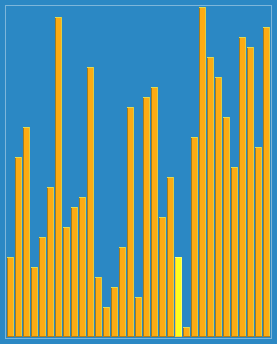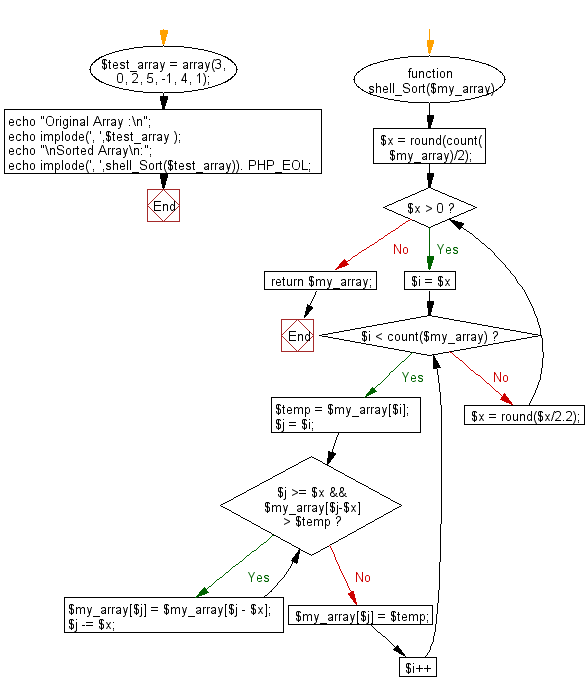PHP Searching and Sorting Algorithm: Shell sort
PHP Searching and Sorting Algorithm: Exercise-5 with Solution
Write a PHP program to sort a list of elements using Shell sort.
According to Wikipedia "Shell sort or Shell's method, is an in-place comparison sort. It can be seen as either a generalization of sorting by exchange (bubble sort) or sorting by insertion (insertion sort). The method starts by sorting pairs of elements far apart from each other, then progressively reducing the gap between elements to be compared. Starting with far apart elements can move some out-of-place elements into position faster than a simple nearest neighbor exchange."
An example run of Shellsort with gaps 5, 3 and 1 is shown below.

The first pass, 5-sorting, performs insertion sort on separate subarrays (a1, a6, a11), (a2, a7, a12), (a3, a8), (a4, a9), (a5, a10). For instance, it changes the subarray (a1, a6, a11) from (62, 17, 25) to (17, 25, 62). The next pass, 3-sorting, performs insertion sort on the subarrays (a1, a4, a7, a10), (a2, a5, a8, a11), (a3, a6, a9, a12). The last pass, 1-sorting, is an ordinary insertion sort of the entire array (a1,..., a12). As the example illustrates, the subarrays that Shellsort operates on are initially short; later they are longer but almost ordered. In both cases insertion sort works efficiently. Shellsort is unstable: it may change the relative order of elements with equal values. It is an adaptive sorting algorithm in that it executes faster when the input is partially sorted.
Shell Sort

Shellsort with gaps 23, 10, 4, 1 in action.
Sample Solution :
PHP Code :
<?php
function shell_Sort($my_array)
{
$x = round(count($my_array)/2);
while($x > 0)
{
for($i = $x; $i < count($my_array);$i++){
$temp = $my_array[$i];
$j = $i;
while($j >= $x && $my_array[$j-$x] > $temp)
{
$my_array[$j] = $my_array[$j - $x];
$j -= $x;
}
$my_array[$j] = $temp;
}
$x = round($x/2.2);
}
return $my_array;
}
$test_array = array(3, 0, 2, 5, -1, 4, 1);
echo "Original Array :\n";
echo implode(', ',$test_array );
echo "\nSorted Array\n:";
echo implode(', ',shell_Sort($test_array)). PHP_EOL;
?>
Sample Output:
Original Array : 3, 0, 2, 5, -1, 4, 1 Sorted Array : -1, 0, 1, 2, 3, 4, 5
Flowchart :

PHP Code Editor:
Have another way to solve this solution? Contribute your code (and comments) through Disqus.
Previous: Write a PHP program to sort a list of elements using Selection sort.
Next: Write a PHP program to sort a list of elements using Bubble sort.
What is the difficulty level of this exercise?
Test your Programming skills with w3resource's quiz.
PHP: Tips of the Day
How to Sort Multi-dimensional Array by Value?
Try a usort, If you are still on PHP 5.2 or earlier, you'll have to define a sorting function first:
Example:
function sortByOrder($a, $b) {
return $a['order'] - $b['order'];
}
usort($myArray, 'sortByOrder');
Starting in PHP 5.3, you can use an anonymous function:
usort($myArray, function($a, $b) {
return $a['order'] - $b['order'];
});
And finally with PHP 7 you can use the spaceship operator:
usort($myArray, function($a, $b) {
return $a['order'] <=> $b['order'];
});
To extend this to multi-dimensional sorting, reference the second/third sorting elements if the first is zero - best explained below. You can also use this for sorting on sub-elements.
usort($myArray, function($a, $b) {
$retval = $a['order'] <=> $b['order'];
if ($retval == 0) {
$retval = $a['suborder'] <=> $b['suborder'];
if ($retval == 0) {
$retval = $a['details']['subsuborder'] <=> $b['details']['subsuborder'];
}
}
return $retval;
});
If you need to retain key associations, use uasort() - see comparison of array sorting functions in the manual
Ref : https://bit.ly/3i77vCC
- New Content published on w3resource:
- HTML-CSS Practical: Exercises, Practice, Solution
- Java Regular Expression: Exercises, Practice, Solution
- Scala Programming Exercises, Practice, Solution
- Python Itertools exercises
- Python Numpy exercises
- Python GeoPy Package exercises
- Python Pandas exercises
- Python nltk exercises
- Python BeautifulSoup exercises
- Form Template
- Composer - PHP Package Manager
- PHPUnit - PHP Testing
- Laravel - PHP Framework
- Angular - JavaScript Framework
- Vue - JavaScript Framework
- Jest - JavaScript Testing Framework
